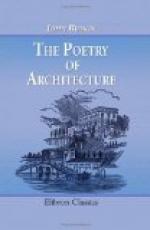19. No building which we feel to excite a sentiment of mere complacency can be said to be in good taste. On the contrary, when the building is of such a class, that it can neither astonish by its beauty, nor impress by its sublimity, and when it is likewise placed in a situation so uninteresting as to render something more than mere fitness or propriety necessary, and to compel the eye to expect something from the building itself, a gentle contrast of feeling in that building is exceedingly desirable; and if possible, a sense that something has passed away, the presence of which would have bestowed a deeper interest on the whole scene. The fancy will immediately try to recover this, and, in the endeavor, will obtain the desired effect from an indefinite cause.
[Illustration: FIG. 1. Old Windows: from an early sketch by the Author.]
20. Now, the French cottage cannot please by its propriety, for it can only be adapted to the ugliness around; and, as it ought to be, and cannot but be, adapted to this, it is still less able to please by its beauty. How, then, can it please? There is no pretense to gayety in its appearance, no green flower-pots in ornamental lattices; but the substantial style of any ornaments it may possess, the recessed windows, the stone carvings, and the general size of the whole, unite to produce an impression of the building having once been fit for the residence of prouder inhabitants; of its having once possessed strength, which is now withered, and beauty, which is now faded. This sense of something lost, something which has been, and is not, is precisely what is wanted. The imagination is set actively to work in an instant; and we are made aware of the presence of a beauty, the more pleasing because visionary; and, while the eye is pitying the actual humility of the present building, the mind is admiring the imagined pride of the past. Every mark of dilapidation increases this feeling; while these very marks (the fractures of the stone, the lichens of the moldering walls, and the graceful lines of the sinking roof) are all delightful in themselves.




